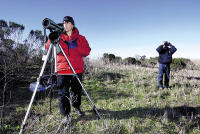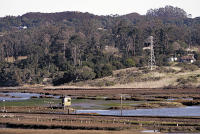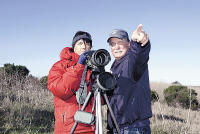 | |||||||||||
|
|
|
|
|
|
|
||||||
|
| |||||||||||
|
December 27, 2009 Underwater wall may bring balance to Elkhorn SloughBy OLGA KUCHMENTMOSS LANDING -- The sun-basking sea otters seemed indifferent to researchers eyeing them from a hillside Wednesday, but it's largely unknown how they will react to the conservation project planned for their Elkhorn Slough neighborhood this summer. The project managers decided this month what the project, an underwater barrier, will basically look like. The nonprofit Elkhorn Slough Foundation received a $3.9 million federal stimulus grant in July to fund construction of an underwater sill in a branch of the main slough called Parsons Slough. They aim to use the sill to preserve the ecosystem by slowing Elkhorn Slough's rampant erosion. It is also expected to create 132 jobs. The grant stipulates that the project be completed by July 2011. "The project tries to restore balance to the ecosystem," said Bryan Largay, director of the Elkhorn Slough tidal wetland project. "The project intends to keep us from losing what we already have." Elkhorn Slough has the state's largest tract of salt marsh other than San Francisco Bay and an incredibly productive ecosystem. The slough's salt marshes, muddy soils and open waters host sea mammals and amphibians, 340 species of birds, 150 species of fish and hundreds of species of invertebrates. But years of human changes affected the region, Largay said. Parsons Slough was diked as part of an old nationwide campaign to reclaim marshes. Its land sank down and most marsh plants there died. In 1908, the redirection of Salinas River curbed Elkhorn Slough's supply of muddy sediment. Without a supply of new soil, marsh plants can't survive rising water levels. Excavating Moss Landing Harbor in the 1940s made the tides higher and more forceful, as did the breaching of dikes in Parsons Slough in the 1980s, Largay said. Elkhorn Slough's soft mud and salt marshes are disappearing, potentially taking productivity and biodiversity with them. If current trends continue, two-thirds of the slough's remaining marshes will disappear by 2050, Largay said. Scientists, conservationists, officials, and members of the public have for several years discussed building a sill that would restrict the channel to Parsons Slough. The sill would lower high tide and raise low tide in Parsons, decreasing erosion and allowing some sediment to collect, which may give marsh plants a leg up. The sill would also decrease the volume of water moving through the system, slowing erosion in the rest of Elkhorn Slough. According to the design project manager, Steve Carroll of North-American conservation group Ducks Unlimited Inc., an underwater row of interlocking steel sheets will span the entrance to Parsons Slough. Rock fill will shape the wall into a pyramid to guide fish and animals across. On top, a series of removable wooden flashboards will allow the channel to be opened up within a few days if things go awry. At its narrowest setting, the sill will leave a 25-foot-wide, at least 5-foot-deep gap for water to pass through. That gap can be widened to 100 feet, which would hardly restrict the tides. The sides of the sill, where it attaches to the railroad bridge, will be above water at high tide. Restricting the channel too much could deprive Parsons Slough water of oxygen, making it inhospitable to wildlife. The project managers plan to monitor water quality and animal behavior for several years after construction. It is difficult to predict exactly how the ecosystem will react. With the sill in place, Parsons Slough should have fewer mud flats and more open water. Water birds will likely be affected by this, Largay said, since open water attracts waterfowl whereas mud flats draw shorebirds. Sharks use Parsons Slough as a nursery. The number of sharks and rays in Elkhorn Slough have increased since the early 1990s, said Sean Van Sommeran of the Santa Cruz-based nonprofit Pelagic Shark Research Foundation. He is skeptical of the project and sees nearby regions as better targets for marsh conservation. "There is talk of stabilizing the slough environment, but it's really at the mercy of sea level and all these other factors," Van Sommeran said. "The wildlife is already thriving." There are many more otters in Elkhorn Slough and Parsons Slough now than in the mid-1990s, said Daniela Maldini of the Moss Landing-based nonprofit Okeanis. The Elkhorn Slough Foundation commissioned her group to begin monitoring sea mammals near Parsons Slough two months ago. The group did one of its 24-hour monitoring sessions Wednesday. Thirty-eight otters appear to spend a lot of time in the area. Maldini said she can't predict how they will react to construction. According to Carroll, the construction will involve about 20 people, three barges with equipment, and some noise from a vibratory hammer. It may take up to four months. Kayakers and boaters disturb the animals but the passing Union Pacific trains and traffic noises do not, Maldini said. The project is part of a larger effort to preserve Elkhorn Slough, but what the Parsons Slough project itself will do for the salt marshes is unclear. Erosion may be damaging them in a complex way. Trish Chapman of the State Coastal Conservancy, a member of the project's strategic planning team, has worked on dam removal projects in the past. She still has some qualms about putting a large structure into an ecosystem. "These systems are so changed and so manipulated by humans that what is restoration is a really hard thing to know." "One of the things I feel quite strongly about is that we're not going back to what it was," said USGS oceanographer Jessie Lacy, a science adviser to the project. "Given the options we have, what range of habitat should we be aiming for?" For information, visit www.elkhornslough.org/tidalwetland/parsons.htm. A public meeting about the project is planned for 6:30 p.m. Feb. 3. The location has yet to be announced. Original URL (may no longer function): http://www.santacruzsentinel.com/localnews/ci_14075938
Copyright © Santa Cruz Sentinel. All rights reserved.
|
 Volunteers Daniela Maldini of Moss Landing and Robert Scoles of Aromas monitor otters and seals in slough for study on effects of proposed Elkhorn Slough Foundation $3.9 million retaining wall to slow down erosion (Dan Coyro/Sentinel)  Volunteer monitors are also set up in the stand at lower left in the photo. (Dan Coyro/Sentinel)  Volunteers Daniela Maldini of Moss Landing and Robert Scoles of Aromas track the movement of seals in Elkhorn Slough Wednesday. (Dan Coyro/Sentinel) |
| |
[ home ] | [ contact us ] | [ support us ] | [ shop ] | © Copyright 1990-2010 PSRF All rights reserved. |
Site Development by IT Director |